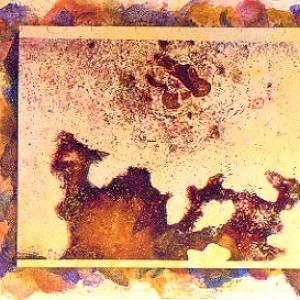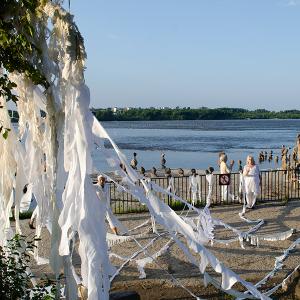From Kenneth Radu: The Sculptures of John Félice Ceprano
These works fall to the force of nature every year and are rebuilt in new formations in late spring and summer when the river releases itself from winter’s grip. The rock remains, the art vanishes, only to reappear, because the artist is moved to do so, change and transformation being essential to his aesthetic. And that’s a rather exciting concept. Ceprano’s purpose is not to create a never changing artifact, but to celebrate the phenomenon of change itself
I spent a happy hour or two one morning this summer among John Félice Ceprano's rock sculptures in the Remic Rapids Park on the Ottawa River.
Ceprano creates an illusion of delicacy and fragility with rocks of various hefts almost balletic and poised, sensitive to movement, an effect heightened by the rapids. And always, in the midst of equilibrium, there’s an intimation of collapse. Which is part of the charm.

From every vantage point his rock sculptures offer delight. The stones gathered out of the river bed are rich with subtle colour, patterns and texture. Although it is understandably forbidden to touch, one’s instinct is to do so. They are both tangible and sensuous. Seemingly precariously balanced, the rocks are wonderfully arranged to form narratives, stories suggested by the titles Ceprano gives the sculptures for he clearly has a vision when he selects and structures the rocks into various and ingenious positions, but they are also susceptible to whatever narrative we choose to see. A heavy rock appears impossibly poised on the tip of another, saved from falling by adroitly placed pebbles and shards of stone.

And that’s another intriguing phenomenon here: the weights and balances, how something as heavy as a rock becomes light, as if it has indeed alighted and nestled itself securely where under ordinary circumstances it should tumble over. Always in the midst of equilibrium, there’s an intimation of collapse which is part of the charm.
Their placement on the rocky shore of the river, the rapids swirling and running among them, inspire thoughts of voyageurs and the native peoples for whom the river was a primordial pathway, the paddlers of canoes on this very water. An historical resonance imbues the atmosphere.

Surrounded by parkland, overlooked by the Ottawa skyscape, we enter a river of events and art, memory and immediacy, the drama of opposites, the play of light and water on solidity. We can step out into the river as far as we are willing to go to view the sculptures, to walk around, bend over, restrain the impulse to caress, and just to admire the art constructed out of common material in public space.
This is very much an art that invites people to participate, an area of visual and physical play, but respecting the integrity of the sculptures at all times. Only nature has the right to dismantle, thereby creating new endeavours for the artist.
I believe classes are conducted teaching children and adults what they can do with stones, to encourage them to see beauty under their feet, to practice the laws of physics and imagine infinite possibilities.
The construction of the sculptures is both a testament to the imperative of art and a sabotage of the notion of monumentality or sculpture as permanent, forever fixed. These works fall to the force of nature every year and are rebuilt in new formations in late spring and summer when the river releases itself from winter’s grip. The rock remains, the art vanishes, only to reappear, because the artist is moved to do so, change and transformation being essential to his aesthetic.
And that’s a rather exciting concept. Ceprano’s purpose is not to create a never changing artefact, but to celebrate the phenomenon of change itself, to embody perhaps universal principles of tensions, balance, harmonies, contradictions, energy and stasis, elegance and lightness ironically depending upon the solidity of rock.
One becomes aware of the interaction and relationships of water, rock, sky, all of which of course alter during the course of the day. What we see in the morning becomes transformed at sunset, so if possible we should visit the scene at different times of the day, even during a moonlit night.
I am also reminded of Japanese principles of gardening evident in the Jardin Botanique de Montréal: arrangements of rock among flora, the opposing and complementary natural forces at work, the wandering and fallings of water over rocks which themselves have been carefully chosen for their male and female properties, their apparent and inherent nature, the conjoining of differences to establish a harmonious whole. Sound and movement of the water, rocks chosen for their specific virtues as true of the classic Japanese garden as it is of Ceprano’s sculptures, sky and city, sun and shadows, trees and wind: geography is essential here.
The artist finds and founds his art in this particular locale. It’s an art emerging annually from an individual mind in a specific public place. In a sense, with some slight alteration of its original meaning, the term genius loci is applicable to John Félice Ceprano.

Kenneth Radu has published five novels, three volumes of poetry, a memoir, and four collections of short stories, the latest being Sex in Russia (DC Books Canada, 2010). He has twice won the Quebec Writers’ Federation prize for fiction, for A Private Performance (Véhicule Press) and Distant Relations (Oberon Press). His first book of stories, The Cost of Living (The Muses’ Company/La compagnie des Muses) was shortlisted for the Governor General’s Award for Fiction. Now retired from teaching, he lives with his wife in St-Polycarpe, a village not far from Montreal. An avid gardener, he is also writing another novel and revising a new collection of stories.
Photos of Ceprano's Rock Sculptures by Kenneth Radu.
Directions to Remic Rapids Park: Take exit 123 from HWY 417 onto Island Park Drive.
Turn right onto Ottawa River Parkway. Drive east and turn left onto entry to park (opposite Tunney’s Pasture). [Also accessible via Parkdale Avenue North.]
Rating 5.0 (1 vote)







